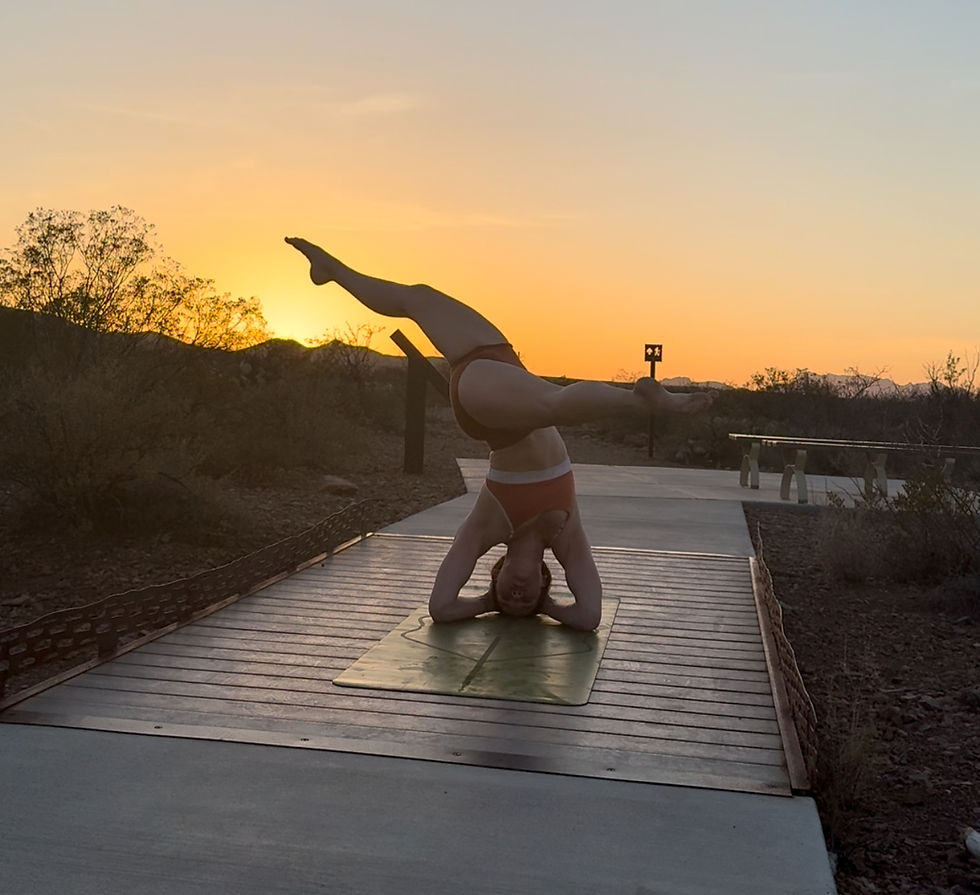Beth’s Yoga Journal | Day 003: What Nature Teaches Us About Resilience: 2 Simple Daily Practices
- Bethan Dix
- Jul 30
- 3 min read

We’ve been taught that resilience means pushing through. That it’s about staying strong, staying busy, staying upright. That to be resilient is to never flinch, never fall, never bend.
But nature whispers a different truth. One that is softer and far more alive.
🌳 Resilience Doesn’t Always Look Like Strength
Think of a tree after a storm, its branches bent, some stripped bare, its bark softened by rain, its roots deep in the soaked soil.
It doesn’t stand tall out of defiance. It stands because it yielded. It swayed. It listened to the wind. It knew not to resist what could not be controlled.
Nature doesn’t force its way back to balance. It pauses. It recovers. It trusts the rhythm.
In winter, trees stop growing, not because they’ve given up, but because they know that true restoration comes through rest. This isn’t weakness. It’s wisdom.
🧠 Micro-Rest Beats Mega-Burnout
In modern life, we often wait until we’re burnt out before we give ourselves permission to rest. But research tells a different story.
The American Psychological Association has shown that small, daily restorative practices, like mindful movement, breathwork, or walking in nature are more effective at building resilience than waiting for big breakdowns or relying on occasional “fixes.”
These micro-habits lower cortisol, improve emotional regulation, and enhance neuroplasticity — your brain’s ability to adapt and heal over time.
🌀 Resilience Is the Dance Between Stress and Recovery
Much like building muscle, resilience grows through contrast.
Challenge followed by rest. Tension followed by softening. Effort followed by exhale.
It’s not about avoiding stress—it’s about how we respond to it.
When we allow ourselves to pause, breathe, and recalibrate, we don’t become weaker. We become more adaptable. More connected to what matters. More alive in our own rhythm.
🌬 Breath Is Your Built-In Reset
The simplest, most profound practice I return to? Breath.
Just a few slow, conscious breaths can shift the body from fight-or-flight into rest-and-restore mode. This happens through the vagus nerve, a key part of the parasympathetic nervous system the one that helps you rest, digest, and feel safe again.
Slow breathing improves heart rate variability, reduces anxiety, and returns us to presence — even in the middle of the storm.
Explore the science of breath and nervous system repair ›
🌿 A New Definition of Resilience — Try These Two Practices Today
So what if resilience isn’t about never falling apart? What if it’s about knowing how to return in slower ways, in softer rhythms, in connection with something wilder and wiser than the world we’re rushing through?
Here are two gentle, powerful practices to try today, both backed by science and rooted in nature’s way of healing:
1. Sensory Nature Walk (10–15 minutes)
Let this be a walk without a goal. No steps to count, no pace to keep. Just walk to notice.
Try this:
Step outside, ideally somewhere with trees, grass, or even just the sound of birds or rustling leaves.
As you move, pause often. Let your senses guide you.
Ask yourself: What are three things I can hear? What does the air smell like? What textures can I feel with my fingertips or bare feet?
Stay present with whatever you notice, the warmth of the sun on your skin, the cool breeze across your face, the softness of moss or the firmness of bark.
Why it helps: This kind of sensory immersion (also known as forest bathing) activates your parasympathetic nervous system, reduces cortisol, and brings you back into a grounded state of presence. It’s not about the distance you walk, but the depth of your attention.
2. Breath Reset: 4–6 Breath Practice (2–5 minutes)
This is your nervous system’s built-in reset button. Use it any time you're feeling tense, overwhelmed, or untethered.
Try this:
Find a quiet spot to sit or lie down.
Inhale slowly through the nose for a count of 4.
Exhale gently through the mouth or nose for a count of 6.
Repeat this for 2 to 5 minutes, letting each breath be a little slower than the last.
If you like, rest a hand on your belly or heart to anchor your awareness.
Why it helps: This extended exhale pattern signals safety to the brain via the vagus nerve. It helps regulate heart rate variability, calms anxiety, and builds long-term resilience by teaching the body how to return to baseline after stress.
✨ Want to Explore This More?
This is Day 002 of Beth’s Yoga Journal: a 30-day journey through embodied healing, nervous system support, and the wisdom of the natural world.
🌀 Read Day 001 ›👉 www.bendwithbee.com/journal-day001
📩 Join the newsletter for guided practices + retreat updates👉 www.bendwithbee.com/newsletter
🧠 Explore the research and science I’m referencing👉 APA: Resilience Interventions



Comments